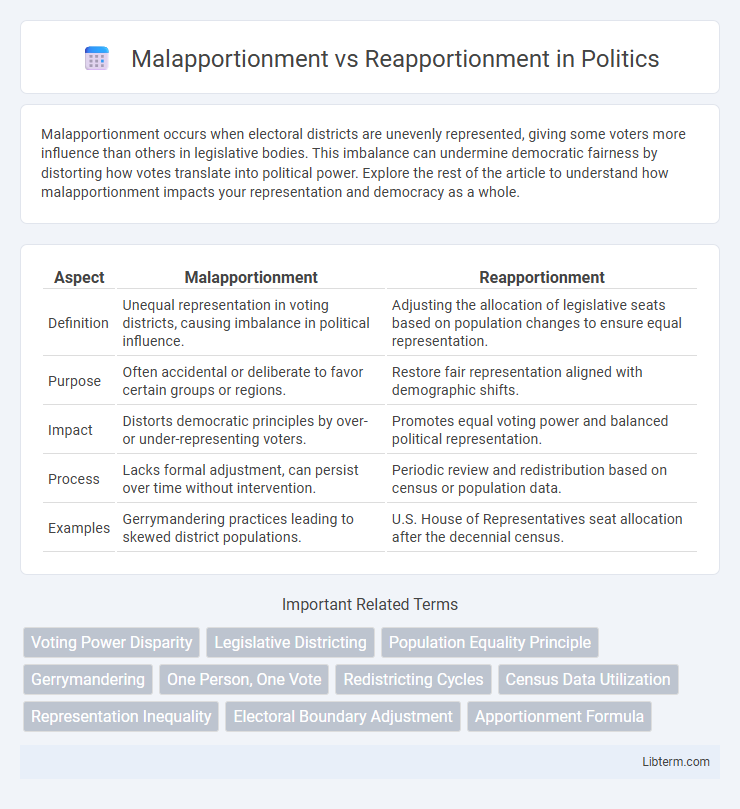Malapportionment occurs when electoral districts are unevenly represented, giving some voters more influence than others in legislative bodies. This imbalance can undermine democratic fairness by distorting how votes translate into political power. Explore the rest of the article to understand how malapportionment impacts your representation and democracy as a whole.
Table of Comparison
| Aspect | Malapportionment | Reapportionment |
|---|---|---|
| Definition | Unequal representation in voting districts, causing imbalance in political influence. | Adjusting the allocation of legislative seats based on population changes to ensure equal representation. |
| Purpose | Often accidental or deliberate to favor certain groups or regions. | Restore fair representation aligned with demographic shifts. |
| Impact | Distorts democratic principles by over- or under-representing voters. | Promotes equal voting power and balanced political representation. |
| Process | Lacks formal adjustment, can persist over time without intervention. | Periodic review and redistribution based on census or population data. |
| Examples | Gerrymandering practices leading to skewed district populations. | U.S. House of Representatives seat allocation after the decennial census. |
Understanding Malapportionment: Definition and Implications
Malapportionment occurs when electoral districts are unevenly represented compared to their population sizes, leading to unequal voting power and distorted political influence. This imbalance undermines democratic principles by granting disproportionate weight to certain districts, often favoring rural areas over urban ones. Reapportionment is the process designed to correct malapportionment by redistributing legislative seats based on updated population data from the census.
What is Reapportionment? An Overview
Reapportionment is the process of redistributing legislative seats based on population changes reflected in the decennial census, ensuring equal representation for populations across electoral districts. It addresses malapportionment by adjusting the number of representatives each area receives to prevent overrepresentation or underrepresentation. This process is fundamental in maintaining democratic fairness and proportionality in legislative bodies.
Key Differences Between Malapportionment and Reapportionment
Malapportionment refers to the unequal distribution of legislative seats that results in some districts having significantly more representation than others, often skewing political power. Reapportionment is the process of redistributing legislative seats based on updated population data, ensuring fair and proportional representation across districts. The key difference lies in malapportionment causing imbalance and potential disenfranchisement, while reapportionment aims to correct representation disparities in response to demographic changes.
Historical Examples of Malapportionment
Historical examples of malapportionment include the U.S. Supreme Court cases Baker v. Carr (1962) and Reynolds v. Sims (1964), which addressed unequal representation due to disproportionate legislative districts. In Japan, the Supreme Court ruled on malapportionment issues in the 1970s and 1980s, highlighting significant population disparities between rural and urban electoral districts. These cases demonstrate how malapportionment undermines the principle of "one person, one vote" by granting unequal political power to certain regions or demographics.
The Role of Reapportionment in Democratic Systems
Reapportionment ensures equal representation by adjusting electoral district boundaries based on population changes, correcting malapportionment where some districts have disproportionate voter influence. This process maintains the principle of "one person, one vote," enhancing fairness and legitimacy in democratic systems. Effective reapportionment prevents political inequality and supports balanced policymaking reflective of current demographics.
Causes and Consequences of Malapportionment
Malapportionment occurs when electoral districts are unevenly populated, causing unequal representation and undermining the principle of "one person, one vote." Causes include population shifts, gerrymandering, and outdated district boundaries, which distort political power by overrepresenting certain regions or groups. Consequences of malapportionment include diminished political equity, voter disenfranchisement, and policy outcomes that favor overrepresented districts, leading to systemic imbalance and reduced democratic legitimacy.
Legal Framework Governing Reapportionment
The legal framework governing reapportionment is based primarily on constitutional mandates and judicial interpretations that ensure equal representation through population-based district adjustments. Landmark cases like Baker v. Carr (1962) and Reynolds v. Sims (1964) established the principle of "one person, one vote," requiring legislative districts to have roughly equal populations to prevent malapportionment. Statutory guidelines and state constitutions further regulate the redistricting process to uphold fairness, transparency, and compliance with voting rights laws.
Addressing Malapportionment: Reforms and Solutions
Addressing malapportionment requires implementing reforms such as regular reapportionment based on updated census data to ensure equal representation in legislative bodies. Legal measures like the "one person, one vote" principle established by landmark court cases promote equitable district boundaries, reducing disparities in voter influence. Technological advancements in geographic information systems (GIS) facilitate more precise and transparent redistricting processes, combating malapportionment effectively.
Impact of Malapportionment and Reapportionment on Representation
Malapportionment skews political representation by creating electoral districts with vastly unequal populations, resulting in some votes carrying more weight than others and undermining democratic fairness. Reapportionment adjusts district boundaries based on population changes from the census, aiming to equalize representation and ensure legislative seats reflect demographic shifts. Effective reapportionment corrects malapportionment, promoting equitable voter influence and enhancing the legitimacy of representative institutions.
Malapportionment vs Reapportionment: Future Challenges and Trends
Malapportionment, which refers to uneven representation due to unequal population distribution among electoral districts, presents significant challenges for democratic fairness and political equity. Reapportionment efforts aim to rebalance representation based on updated census data, but future trends must address rapid demographic shifts, urbanization, and technological advancements in data collection. Emerging challenges include ensuring accurate, timely redistricting processes and mitigating partisan gerrymandering to maintain proportional representation and uphold voting rights.
Malapportionment Infographic

 libterm.com
libterm.com